Dedication
At some point in our lives we are all plagued with health issues. I have been dealing with heart issues over the last ten years. My heart issues have been managed through medical expertise, compassion, and a focused program of medical maintenance. My wife, Bev, in her position as Chairman of the Board of Aurora Healthcare some years ago, connected me with Dr. Bijoy E. Khandheria and the Aurora Global and Executive Healthcare Program.
Dr. Khandheria, was brought to Milwaukee from Mayo Clinic where he had served as the Chair of Mayo Clinic’s Cardiovascular Diseases Division. Dr. Khanderia has been a guiding light in the maintenance of my health, attitude, and willingness to follow directions. He is a doctor’s doctor who is able to explain the words of medicine and the choices in a clear and concise manner. Though the leadership of Dr. Nick W. Turkal, President and CEO of Advocate Aurora Health, Dr. Khanderia and others, St. Luke’s is an international brand and one of the best Heart Hospitals in the United States
Over this past month, I once again experienced health issues. Dr. Khandheria and the capable team at St. Luke’s, including Dr. Eric Gallin Roberts, Dr. Aul Bhatia, Dr. Tarif Samadi, and others, made sure there was a professional and quick way to recovery. I heartfully thank the exceptional nurses at St. Luke’s for their professionalism and attentive kindness. And, of course, I want to gratefully acknowledge Judy Beiler, Jenny Lesniewski, Maria Welk, and Jessica Barnett of the Global and Executive Healthcare Program.
I am entering the twilight of my career and have very much enjoyed practicing law in the areas of sports and real estate. I have been provided opportunities that most solo practitioners will never experience. But of all my experiences, teaching law at Marquette University Law School for the last 47 years has been the most enjoyable and heartfelt experience of my life. The ability to teach a law school course and to continue writing on Sport$Biz has meant the world to me. The law students continue to provide me with confidence in our future.
My supportive wife, Bev, and my children, Kari Altman and Dr. Steven Greenberg, have kept a close eye on me and provided me with the love that fueled my recovery.
It is common for me to thank my law students and others that assist in the writing of these articles. As you see though, this thank you is far more than that, it’s a dedication that is made with the deepest gratitude to the phenomenal medical team that I have had the privilege to work with. It gives me great peace of mind to know that they are in my corner and working hard to make it possible for me to continue doing the things that I enjoy most.
By Martin J. Greenberg, Andrew Mentzer, and Madeline Wergin
I. INTRODUCTION
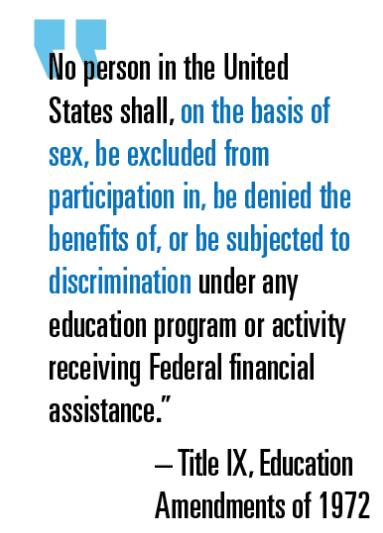 Title IX is a federal civil rights law, and applies to all departments (academics and athletics) in all educational institutions that receive federal funds.[1] Title IX of the Educational Amendments of 1972 states: “[n]o person in the United States shall, on the basis of sex, be excluded from participation in, be denied the benefits of, or be subjected to discrimination under any education program or activity receiving Federal financial assistance.”[2] Although the statute does not explicitly cover sexual harassment or sexual violence within the definition of “sex discrimination,” Title IX, by virtue of Supreme Court decisions and Regulations of the US Department of Education, does in fact cover sexual harassment conduct, as well as gender discrimination, sex violence, retaliation, and hostile environments.[3]
Title IX is a federal civil rights law, and applies to all departments (academics and athletics) in all educational institutions that receive federal funds.[1] Title IX of the Educational Amendments of 1972 states: “[n]o person in the United States shall, on the basis of sex, be excluded from participation in, be denied the benefits of, or be subjected to discrimination under any education program or activity receiving Federal financial assistance.”[2] Although the statute does not explicitly cover sexual harassment or sexual violence within the definition of “sex discrimination,” Title IX, by virtue of Supreme Court decisions and Regulations of the US Department of Education, does in fact cover sexual harassment conduct, as well as gender discrimination, sex violence, retaliation, and hostile environments.[3]
Title IX requires that once a college or university knows of, or reasonably should know of, possible sexual harassment of students, it must take “immediate and appropriate steps to investigate or otherwise determine what occurred and take prompt and effective steps reasonably calculated to end any harassment, eliminate a hostile environment if one has been created, and prevent harassment from occurring again,” regardless of whether the student who has been harassed complains of the harassment or asks the college to act.[4] A university or college has notice of the alleged harassment if a responsible employee “knew, or in the exercise of reasonable care should have known,” about the harassment.[5] A responsible employee would include:
(1) Any employee who has the authority to take action to redress the harassment,
(2) Any employee who has the duty to report to appropriate school official’s sexual harassment or any other misconduct by students or employees, or
(3) An individual who a student could reasonably believe has the above authority or responsibility.[6]
A responsible employee must report incidents of sexual violence and/or sexual harassment to the Title IX coordinator or another appropriate university or college designee.[7]
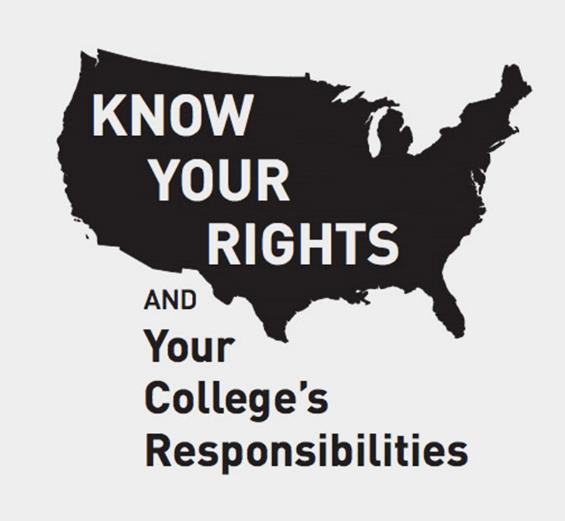 II. RESPONSIBLE EMPLOYEE
II. RESPONSIBLE EMPLOYEE
Under Title IX, it is likely that coaches would have a duty to promptly report incidents of sexual violence to the appropriate university or college designee due to their classification as a responsible employee. This duty would likely supersede a coach’s contract regarding reporting obligations. Below is a cursory examination of various universities and colleges who have explicitly classified coaches as responsible employees, or where one can infer that a coach is likely to be deemed a responsible employee due to their position not falling under a confidential resource/reporter category.
- University of Baylor
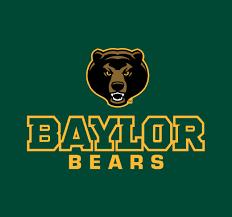
At Baylor, pursuant to their Sexual and Gender-Based Harassment and Interpersonal Violence Policy, every employee is designated as either a confidential resource or a responsible employee.[8] A confidential resource is any employee who is a licensed medical, clinical, or mental-health professional when acting in that professional capacity.[9] A confidential resource also includes the Baylor University Chaplain when acting within a ministerial or pastoral role in the provision of services to students.[10] Confidential resources do not have a duty to disclose information without consent from the individual.[11]
If an employee does not fall within the category of “confidential resource,” then they are automatically deemed a responsible employee. Responsible employees are required to report immediately any information they know about suspected prohibited conduct or potential violations of the policy.[12] Therefore, one can infer that because coaches and coaching staff are not likely to fall under the category of “confidential resources,” then they must be classified as responsible employees. Because they are likely to be responsible employees, the coaches and staff should have a duty to report sexual misconduct regardless of what their coaching contract states.
- Ohio State University (OSU)

Similar to Baylor’s sexual harassment policy, Ohio State’s Sexual Misconduct policy requires the duty to report as follows:
- The university is committed to stopping sexual misconduct, preventing its recurrence, eliminating any hostile environment, and remedying its discriminatory effects. All university employees have reporting responsibilities to ensure the university can take appropriate action.
- Employees with a duty to report should refer to the chart in section V-Reporting Allegations of Sexual Misconduct.
- All university employees, except those exempted by legal privilege of confidentiality or expressly identified as a confidential reporter, have an obligation to report incidents of sexual assault. Any employee who receives a disclosure of a sexual assault or becomes aware of information that would lead a reasonable person to believe that a sexual assault may have occurred involving anyone covered under this policy, must report all known information immediately.
- In addition to the requirement of reporting incidents of sexual assault, the following members of the university community have an additional obligation to report all other incidents of sexual misconduct, when they receive a disclosure of sexual misconduct or become aware of information that would lead a reasonable person to believe that sexual misconduct may have occurred involving anyone covered under this policy. These individuals must report the incident within five work days of becoming aware of such information:
- Any human resource professional (HRP);
- Anyone who supervises faculty, staff, students, or volunteers;
- Chair/director; and
- Faculty member. [13]
All employees of OSU are obligated to report incidents of sexual assault and other incidents of sexual misconduct. However, “all employees” is limited to those who have not been exempted by legal privilege of confidentiality or expressly identified as a confidential reporter. OSU does add an additional obligation of reporting all other incidents of sexual misconduct if the employee is “any human resource professional,” “anyone who supervises faculty, staff, students, or volunteers,” “chair/director,” and “faculty member.”[14] Thus, the coaches at OSU seem to be classified as a responsible employee for purposes of reporting incidents of sexual misconduct.
- Marquette University (Marquette)

As compared to Baylor and OSU, where one can infer that coaches would be a responsible employee, Marquette explicitly states that athletic coaches and staff and club sports coaches and assistant coaches are classified as responsible employees.[15] In fact, Marquette considers all university employees as responsible employees who have a duty to report actual or suspected harassment, discrimination, or sexual misconduct to appropriate officials.[16] The only university employees who are not considered responsible employees are the Counseling Center staff, Marquette University Medical Clinic staff, or ordained ministers in their pastoral role.[17] Therefore, the coaches and staff at Marquette have a duty to report incidents of sexual misconduct.
- The University of Nebraska – Lincoln (Nebraska)

University policy indicates that not all university employees are designated as responsible employees, and in fact, most university faculty and staff members are not responsible employees.[18] However, the University has an expansive list of positions who are classified as responsible employees and who are required to take action or report incidents of sexual misconduct. The University deems the following employees of the athletic department as responsible employees: Athletic Director, Senior Associate Athletic Directors, Associate Athletic Directors, Senior Management Team, Directors of Operations, Assistant Directors of Operations, Sport Administrators, Human Resources Director, Human Resource Generalists, Title IX Liaisons, Head Coaches, Assistant Coaches, Associate Coaches, Volunteer Coaches, Strength Coaches, Life Skills Coordinators, Academic Counselors, Athletic Trainers, Compliance Office Staff, Equipment Manager, Sports Nutrition Staff, and Recruiting Staff.[19] Thus, coaches at Nebraska are in fact responsible employees and they do have a duty under federal law to report any violations.



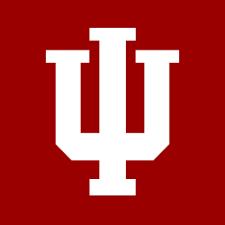
- Michigan Tech, University of Wisconsin – Milwaukee (UWM), University of Texas (UT), Indiana University (IU), and University of North Carolina (UNC)
Michigan Tech considers athletics and recreation staff as responsible employees per their Title IX policy.[20] Under UWM’s Title IX policy, UWM labels 16 positions as being responsible employees – included in these positions are athletic department coaches and administrative staff.[21] Per UT’s “Responsible Employee Resource Guide,” a responsible employee does encompass coaches.[22] IU labels “all coaches and other athletic staff that interact directly with students” as responsible employees.[23] UNC also lists coaches as a responsible employee.[24] Therefore, Michigan Tech, UWM, UT, IU, and UNC coaches all have an obligation to report Title IX violations.
III. UNIVERSITY OF BAYLOR SCANDAL 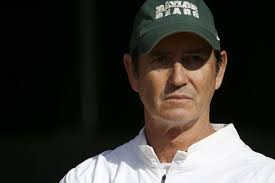
The scandal that unfolded at Baylor was a direct result of a lack of having a definitive Title IX structure in place. The Athletic Department had free roam to govern itself, promoting a culture that deeply impacted female students in the most negative manner. Specifically, this culture was allegedly cultivated during Art Briles (“Briles”) tenure as head football coach at Baylor. He allegedly allowed the football program to leave Baylor in a state of Title IX turmoil.
From top to bottom, Baylor failed its students. Baylor lacked any formal resources in supporting Title IX implementation and enforcement. University administrators acted independently, having little uniformity in decisions regarding sexual violence claims. In many instances, athletic department employees actively engaged in withholding claims from other University officials. These employees failed to report misconduct by student athletes, which then promoted the culture that football was “above the law.”
- Hiring of Briles and the Culture Created
On November 28, 2007, Briles was named the new Baylor head football coach.[25] He was charged with turning around a program, which finished last in the Big 12 the past thirteen of fourteen seasons.[26] Subsequently, Briles hired Colin Shillinglaw (“Shillinglaw”) as the head of football operations.[27] Baylor as a whole prioritized what Briles brought to the field over the livelihood of its female students who were directly affected by sexual violence committed by Briles’ players off the field.
Briles and his staff brought a number of players to Waco, Texas that were directly involved in numerous sexual violence claims.[28] These players were protected time after time by the Athletic Department and the President of Baylor. Players including Tevin Elliot, Shawn Oakman, and Sam Ukwuachu allegedly committed a number of sexual violence acts during their time at Baylor University.[29] All of these players were convicted by a court of a law for some type of sexual violence charge – proving Baylor had failed to act on a number of allegations during these players time at Baylor.[30]
A former student’s lawsuit against Baylor alleged 52 counts of rape, committed by 31 football players between 2011 and 2014.[31] Additionally, there were at least five reported gang rapes, two that were conducted by 10 or more different Baylor football players.[32] This reported sexual violence is directly related to the inaction by athletic personnel.
Throughout Briles’ tenure at Baylor, Baylor administration, campus police, and Waco police were all involved in a lack of transparency involving football player misconduct. It was not until August of 2015, when a Texas Monthly article spelled out a number of alarming allegations and Sam Ukwauchu was convicted of sexual assault by a court of law, did the Board of Regents (“Board”) react.[33] The Board failed to understand why the Office of Judicial Affairs cleared Ukwauchu of any illicit conduct based on the surrounding facts.[34] This prompted the Board to seek an outside independent investigation of the alleged conduct by Pepper Hamilton LLC (“Pepper”).[35] Pepper is a U.S. based law office with 13 offices and over 400 lawyers across the country.[36] Pepper is headquartered in Philadelphia, Pennsylvania.[37]
- Pepper Report

At the center of a damaging independent investigation conducted by Pepper, was an absence of Baylor to employ any formal structure in place to enforce Title IX or follow the authority and guidance of the Violence Against Women Reauthorization Act of 2013 (VAWA).[38] Pepper had been hired in the past to investigate sexual assault scandals at universities and colleges across the country including UC Berkeley, the University of North Carolina, Amherst College, and Occidental College.[39] The leading investigators, Gina Maisto Smith and Leslie M. Gomez, are nationally recognized Title IX experts.[40]

- Overview
The investigation began in August of 2015 and lasted until May of 2016 when the Board was presented with the Pepper Report.[41] Pepper conducted over 65 interviews of personnel and reviewed over one million pieces of data and information.[42] The Report focused on Baylor’s actions between 2012 to 2015.[43] The interviews conducted involved every department associated with Baylor, including: the President’s Office, Judicial Affairs, the Office of General Counsel, the Athletic Department, the football program, and the Baylor University Police Department.[44] Additionally, Pepper looked at the current policies and procedures surrounding Title IX implemented at Baylor and the Judicial Affair investigations.[45]
- Lack of Structure
The Report found an overwhelming failure to implement any structure pursuant to Title IX within the University related to authority and guidance when dealing with reports of sexual assault and violence.[46] The failure of a collective implementation effort by senior leadership led to the lack of infrastructure encouraged by the Department of Education’s Office for Civil Rights regarding Title IX.[47] Before November of 2014, the Report determined that Baylor lacked a proper administrator to oversee Title IX implementation.[48] Instead, Baylor relied on an existing Student Code of Conduct and Civil Rights Policy applied to all employees and students.[49]The Report concluded that the institution failed at every level and Baylor lacked any formal policy, training, or discipline guidance.[50] This created an unsafe culture and community at Baylor.[51]
- Handling of Claims
An analysis of sexual assault reports from Baylor’s academic years starting in 2012 until 2015 revealed a lack of traction in any type of judicial process.[58] A majority of reports lacked any kind of investigation or inquiry into the claims.[59] The Report concluded Baylor acted against its own students’ interests, and created barriers that discouraged the Title IX process.[60] The investigations that took place were inadequate and unreliable in evaluating where sexual violence had occurred.[61] Baylor actively engaged in behavior that shifted blame to victims and turned a blind eye to many other factors.[62] If an investigation took place, witnesses were not questioned, evidence was not gathered, and the standard “preponderance of the evidence” was inconsistently used as Baylor usually applied a much greater level of proof. [63]
Even with the lack of structure, the main problem at Baylor was the administration and athletic department employees who actively engaged in behavior that resulted in significant harm to sexual violence complaints.[64] These actions created more of a hostile environment at Baylor instead of solving the ongoing issues brought to administrators’ attention.[65] Specifically, the actions taken by athletic personnel in implementing Title IX directly promoted the idea that football was “lawless.”[66] The Report found specific instances where the Athletic Department failed to act after receiving information about sexual assaults committed by football players.[67]
More importantly, football personnel met directly with the victims or the parents of complainants, handling everything internally.[68] These individuals conducted their own investigations and measures of discipline.[69] These football personnel allowed this misconduct to occur, and internalized all aspects of the investigation after an act of sexual violence took place.[70] These actions created a hostile environment at Baylor resulting in the failure to protect student safety.[71]
- Board’s Reaction
The Board spent two-weeks sifting through the Report trying to determine its best course of action for Baylor moving forward.[72] The Board put Athletic Director, Ian McCaw’s (“McCaw”), and Briles’ future at the University up for vote.[73] The first vote, 24-6, called for Briles suspension with the intent to terminate.[74] The second vote, 26-4, called for McCaw’s resignation.[75] In addition to the Board’s decision on personnel, it planned the implementation of 105 recommendations made in the Report to bring Baylor under compliance with Title IX.[76]
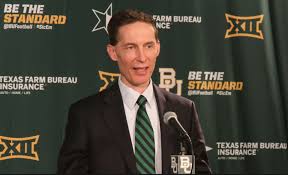 On May 24, 2016, both McCaw and Briles were able to address the Board, answering a question of what to do in the wake of what has happened at Baylor involving sexual violence.[77] After hearing both men speak, the Board recommended McCaw be placed on probation with sanctions, but the motion to reconsider Briles future failed overwhelmingly.[78]
On May 24, 2016, both McCaw and Briles were able to address the Board, answering a question of what to do in the wake of what has happened at Baylor involving sexual violence.[77] After hearing both men speak, the Board recommended McCaw be placed on probation with sanctions, but the motion to reconsider Briles future failed overwhelmingly.[78]
On May 26, 2016, the Board released the Findings of Fact to the public, which summarized Baylor’s failure to implement Title IX.[79] The document did not name any personnel by name for legal reasons but gave a detailed description of just how bad the situation at Baylor had become.[80] On May 30, 2016, McCaw resigned from his position as Athletic Director with Baylor.[81]
The next question the Board needed to answer was what they would do with Briles. In mid-June of 2016, a settlement was reached, and a joint statement was released:
Both parties acknowledge that there were serious shortcomings in the response to reports of sexual violence by some student-athletes, including deficiencies in University processes and the delegation of disciplinary responsibilities with the football program. Baylor is addressing these shortcomings and making ongoing improvements. Baylor wishes Coach Briles well in his future endeavors. Coach Briles expresses his thanks to the City of Waco, and wishes the Baylor Bears success in the future.[82]
In addition to such an unapologetic admission of fault and hinderance of female student safety, Briles left Baylor with a check for $15.1 million dollars.[83] Ken Starr (“Starr”), the University President who stepped down, was also paid $4.5 million in a similar settlement.[84] Unfortunately for Baylor, it paid the price for not having a reporting structure in place.
- Aftermath
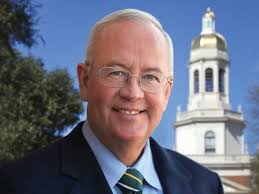
Baylor’s nightmare did not end after the settlements were finalized and ties with Briles and Starr were severed. The NCAA and the Big 12 were now investigating Baylor. Additionally, Patty Crawford, Baylor’s first Title IX coordinator, resigned only a year into the job, citing accusations of Baylor interfering with her job to investigate.[85] Crawford cited a total of 125 reports of sexual assault and harassment that took place between 2011 and 2015.[86]
The Big 12 Conference sanctioned Baylor with a multi-million dollar fine on February 8, 2017.[87] These sanctions will withhold a quarter of Baylor’s future revenue, and will be in effect until the Big 12 has determined that Baylor follows Conference bylaws and Title IX regulations.[88] Baylor responded with an intention to fully cooperate with all of the Big 12 requirements to receive annual distributions.[89]
Briles brought a civil suit against Baylor for defamation in December of 2016, which was subsequently dropped in February of 2017 after Baylor released text messages Briles sent while at Baylor.[90] The text messages show Briles knew about the player misconduct incidents and actively engaged in covering those incidents up.[91] After Briles’ suit was dropped, Shillinglaw, the former head of football operations, brought a similar suit against Baylor.[92] Shillinglaw was fired on May 26, 2016, after Baylor released the “Finding of Facts” to the public.[93] Shillinglaw’s suit was found frivolous by the 170th State District Court in Waco in July of 2017, where summary judgement was granted in favor of Baylor.[94]
On October 1, 2018, the NCAA finally completed the investigation it began in 2017.[95] Baylor has received formal notice of allegations of lack of institutional control from the NCAA surrounding Briles’ tenure as head coach on or about October 1, 2018.[96] Baylor had 90 days to respond to this notice, then the NCAA will reply within 60 days.[97] A final resolution is expected in 2019 following an NCAA Committee on Infractions hearing.[98]
On March 7, 2019, United States District Court Judge Robert Pitman granted the Plaintiff’s Motion to Compel in the Jane Doe 1, et al. vs. Baylor University, et al. that was filed on June 15, 2016 in the Western District of Texas, U.S. District Court.[99] The Court ruled that Pepper was “to produce all materials requested by Plaintiffs in the subpoena duces tecum issued to Pepper Hamilton on March 24, 2017.”[100]The Order stated that “[i]f Pepper Hamilton objects to production of any specific documents, or any objections on jurisdictional grounds,” Pepper had until March 15, 2019 to file such a motion.[101] The Court also reminded the parties that “other than the redactions and omissions approved by the Court for FERPA-protected materials, Pepper Hamilton may not withhold any other materials based on FERPA objections.”[102]
As expected, on March 15, 2019 Pepper filed a motion objecting to the production of documents and for specific relief pursuant to the Court’s Order dated March 7, 2019.[103] Pepper maintains that their representation of Baylor ended in February of 2017 when Attorneys Gina Maisto Smith and Leslie Gomez, “who managed Pepper’s representation of Baylor, resigned as partners of Pepper, joined Cozen [O’Connor LLP], and took the Baylor representation with them.”[104]Further, Pepper maintains that they transferred 25 boxes of documents to Cozen along with exchanging electronic data via a collaboration of Pepper and Cozen’s information technologies’ offices between February of 2017 and March of 2017.[105] As such, Cozen, as counsel for Baylor, is more prepared to produce documents responsive to the subpoena issued nearly two years ago.[106] Further, Pepper concludes that it would be unduly burdensome to rule that Pepper is required to produce documents that are already in the possession of Baylor’s counsel.[107]Judgment on this motion is pending.
IV. TEXAS A&M UNIVERSITY SEXUAL MISCONDUCT (Texas A&M) 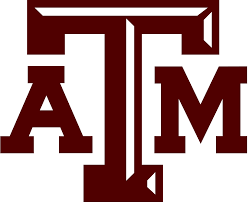
An event that happened in 2016 triggered outrage throughout the Texas A&M community. When this event was brought to light, current and former Texas A&M students came forward with their stories of surviving sexual assaults and their disappointment with the way the University handled the complaints. Responding to the backlash, Texas A&M has been in the process of reviewing and changing their disciplinary process when it comes to sexual assault.
- Hannah Shaw’s Story
In September of 2015, a varsity swimmer, Austin Van Overdam (“Van Overdam”), allegedly sexually assaulted a fellow student, Hannah Shaw (“Shaw”).[108] On one night in September 2015, Shaw logged into Tinder looking for a date, and ended up matching with Van Overdam.[109] After some brief conversations, Van Overdam invited Shaw to his on-campus apartment.[110] Once in his apartment, the two wasted no time and started having consensual intercourse.[111] Shaw stated that she was fine with having sex, but she did not agree to anal sex.[112] She told him “no” and tried to pull away but he held her down by her wrists.[113] After both forms of intercourse were completed, Shaw then immediately performed oral sex on Van Overdam.[114] Following the three acts of sex, Shaw asked Van Overdam if “she could stay overnight to cuddle” but he said no.[115] Shaw was upset that Van Overdam would not permit her to stay the night, and she asked for a “good night” kiss – Van Overdam again declined.[116]
In April of 2016, Shaw told a doctor on campus about what had happened with her and Van Overdam.[117] A panel of three faculty members found Van Overdam responsible for sexual abuse.[118] Van Overdam was to serve a one semester suspension and one probationary semester once he returned to campus.[119] During the time of his suspension, he was redshirted with the swim team.[120] In March of 2018, Shaw realized that Van Overdam was back on the swim team.[121] On June 4, 2018, she wrote an email to the head swimming coach, Joy Holmes, expressing her disappointment in allowing Van Overdam back on the swim team.[122] She received an email back from Lori Williams, a Senior Associate Athletics Director, stating that she recognized Shaw’s “courage and strength” in expressing her concerns, but that the Athletics Department and its employees along with the student-athletes fully support and adhere to the administrative processes.[123] Shaw protested the swimmer’s reinstatement by taking to Twitter. She tweeted screen shots of emails she received from the University Athletics’ Administrator, as well as emails she received from the Texas A&M itself regarding the disciplinary proceeding.[124]
In June of 2018, Van Overdam sued Texas A&M in federal court for the handling of his case.[125] He alleges that Texas A&M used “illegal bias against male students.”[126] Van Overdam’s attorney states that Van Overdam was “wrongfully disciplined” and is “striking back.”[127] His attorney states that Texas A&M only sided with Shaw because they were pressured by the Department of Education and feared losing federal funding.[128]
Since Shaw’s initial tweet, several current and former Texas A&M students took to social media to share their stories as sexual assault survivors using the hashtag “#MeTooTAMU.”[129] Many of the woman coming forward after Shaw’s viral tweet expressed their disappointment with Texas A&M’s lax procedures for disciplining students who have been accused of sexual assault.
Hannah Shaw’s Viral Tweet: 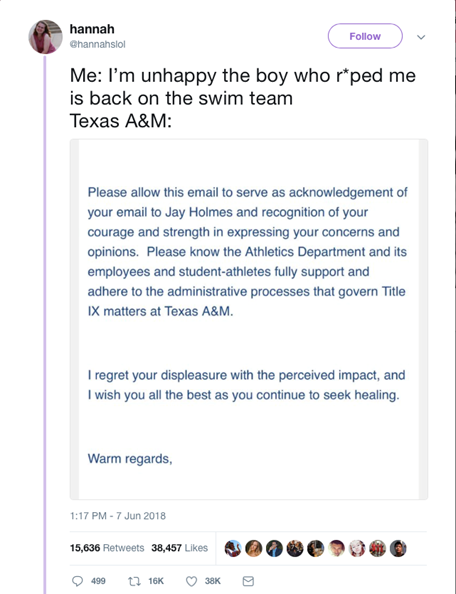
- Megan Romere’s Story
Megan Romere’s (“Romere”) story appeared after Shaw’s tweets regarding her frustration with allowing the man who sexually assaulted her back on the swim team. In October of 2016, Romere, worked as a tutor in Texas A&M’s athletic department.[130] While tutoring Kirk Merritt (“Merritt”), a wide receiver for Texas A&M football team, Romere looked up and saw that Merritt had his hand down his pants.[131] The head of his penis was exposed and he was rubbing it and mumbling while looking at his phone.[132] That night Romere reported the incident to her supervisor.[133] The following day, Romere learned Merritt had done the same thing to another tutor; however, he did not expose himself to that tutor.[134]
Romere sought action from the Student Affairs Conduct Panel.[135] Merritt argued that he had a bad case of “jock itch,” and that he had shaved his pubic hair, which led to itching.[136] The panel believed Merritt and found him not responsible for the charge of sexual exploitation.[137] Romere appealed the decision of the panel.[138] On January 19, 2017, the morning of the appeal hearing, officials explained that they were downgrading Merritt’s charge from sexual exploitation to disorderly conduct.[139] This ultimately reclassified Romere from a victim to a witness.[140] In the hearing, Merritt accepted responsibility for both counts of disorderly conduct.[141] He was reinstated to the football team on February 1, 2017.[142]
Romere believes the University lowered the charge so Merritt could continue playing football.[143] Romere’s father, Bill Romere, posted on Facebook his frustration with how Texas A&M handled the incident, and a reporter picked up the story from his Facebook post.[144] After the story was published, Texas A&M dismissed Merritt from the football team and he lost his scholarship.[145] Bill Romere filed a federal complaint in April of 2017, which led to an investigation.[146] Texas A&M agreed to revise its student code of conduct to ensure that indecent exposure is treated as seriously as other types of sexual harassment.[147] Romere stated: “I thought the university was going to come out on my side, but they only cared about winning.”[148] Romere and other woman who want change from Texas A&M have launched a website called The Twelfth Woman.[149]
- Texas A&M’s Sexual Misconduct Policy
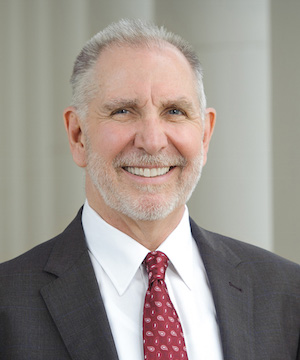
After the wave of backlash stemming from Shaw’s viral tweets, Texas A&M overhauled their sexual misconduct policy. In late June of 2018, Michael Young, Texas A&M’s President, asked a law firm to review the University’s investigative procedures, sensitivity to trauma, best practices in advocacy, and sanctions.[150] Texas A&M also convened an internal panel to review their practices.[151] On July 2, 2018, Texas A&M’s President provided an update regarding plans to improve the way the University addressed sexual assault.[152] On August 20, 2018, President Young, announced eleven actions to be implemented immediately.[153] The approved action plan is as follows:
- New approved sanctioning model for students – this will allow individuals – complainants and respondents and others – to see and know exactly the range of sanctions per violation type and severity if found responsible[154]
- New guidelines for representing the university in extracurricular activities – states that participating in extracurricular activities is a privilege[155]
- Dean of Students decides interim restrictions – the Dean of Students – not a coach, determines restrictions for participation between report intake and hearing[156]
- The decision for eligibility to return to extracurricular activities is made at the investigation hearing, not upon return from suspension[157]
- Update a centralized Title IX omnibus site, to and from which all resources flow[158]
- Enhance and empower Title IX office, redefining role, resources and authority[159]
- Hire four additional positions[160]
- Assign one-on-one case managers to assist students throughout the process[161]
- Expansion and distribution of counselors[162]
- Additional trainings approved[163]
- Transcript notations – students facing possible sanctions of suspension or expulsion will have a hold placed on their transcripts pending resolution of their case[164]
In response to the backlash from students and the #MeToo movement, Texas A&M took steps to help protect victims of sexual assault by overhauling their sexual misconduct guidelines and procedures. Although it took the disappointment and outrage of many former and current students regarding Texas A&M’s policies, Texas A&M is on the right path to be advocates for victims of sexual assault and misconduct.
V. BAYLOR CLAUSE
In the wake of Baylor’s situation reaching national media attention, universities across the country have become more active in addressing the specifics of reporting sexual assaults on campus. Because Baylor lacked any formal contractual language between itself and Briles, requiring reporting sexual violence claims to other authorities in the University, Baylor’s Athletic Department became solely responsible for the scandal.
Other universities have learned from Baylor and made corrections to their policies and coaching contracts. Universities across the country are making sure that policies map out a clear understanding of what is prohibited and how reports should be handled. Secondly, the addition of contractual language requiring coaches to report any incidents of sexual violence to other university officials and administrators creates proper channels for reporting all potential incidents. Universities have gone a step further implementing clauses for termination with cause upon the discovery of the inaction of reporting. Specifically, this type of clause is supposed to prevent coaches from keeping quiet about details regarding players, coaches, and other administrative employee misconduct. This new type of clause in coaching contracts across the country is now known as the “Baylor Clause.”
VI. RECENT CONTRACT TRENDS
As the situation at Baylor became more prevalent outside of Waco, Texas, more universities began to add contractual provisions requiring an affirmative duty to report claims of sexual misconduct. In particular, head football coaching contracts began to include Baylor Clauses, requiring a duty to report any claims of sexual violence to the appropriate Title IX personnel. Below is an examination of some coaching contracts from various colleges and universities across the country. These contracts can be broken into two categories: clauses requiring reporting and clauses requiring termination if there is a failure to report. Under a clause requiring reporting, a coach must report any claim of sexual misconduct. However, there is no specific clause in the contract requiring the university to terminate the coach if the coach fails to report the misconduct. On the other hand, clauses requiring termination add a “just cause” element, which allows the university to terminate the coach for cause if the coach fails to report the sexual misconduct to the appropriate university designee.
- University of Maryland (“Maryland”)
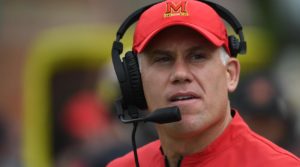
On December 3, 2015, D.J. Durkin (“Durkin”) and Maryland reached an agreement for Durkin to become the head football coach at Maryland.[165] This agreement included one of the first Baylor Clauses implemented in college football. Specifically, paragraph (5) of the contract requires Durkin to abide by Maryland Family Law, and a policy on Reporting Suspected Child abuse.[166] Durkin’s contract requires the reporting of any abuse or sexual misconduct to the local department of social service or law enforcement, and to the President of Maryland, or his designee, the Chief of Campus Police.[167] Additionally, Durkin must follow the University’s Sexual Misconduct Policy as a “Responsible University Employee.”[168] This policy requires “[Durkin] to promptly report any sexual misconduct that comes to his attention to the University’s Office of Civil Rights and Sexual Misconduct.”[169]
Durkin’s contract with Maryland details in Paragraph 12, “Termination,” what constitutes For Cause Termination.[170] For this process to commence, the Athletic Director must first provide Durkin with a written notice and must accord Durkin with an opportunity to be heard at a meeting with the AD.[171] The AD does have the final decision regarding termination.[172] A subsection of Paragraph 12 defines “cause” as, “failure to substantially fulfill the material duties and obligations established in the Agreement . . . .”[173] Here, Durkin must follow paragraph 5 of his contract, where his Baylor Clause lays out as his obligations to report abuse or sexual misconduct. If he fails to report, he risks termination for cause.
- University of Illinois (“Illinois”)
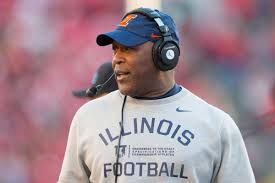
Lovie Smith (“Smith”) and Illinois reached an Employment Agreement on September 8, 2016.[174] In this Agreement, Section 3.2, Responsibilities of the Head Coach, states as follows:
“[Smith] must use best efforts to comply with and implement all applicable standards and requirements of the University, the Football program, and the Governing Rules, including, . . . cooperating with the University in conducting background checks before hiring new employees, promoting an environment committed to diversity and inclusivity, and immediately and properly reporting information related to sexual assault or abuse.”[175]
This clause is another example of a Baylor Clause that requires any and all sexual violence information to be reported immediately to the proper authorities at Illinois.
Smith’s contract Section 5.2, Termination for Cause, gives Illinois the right to terminate Smith’s employment as head coach in the event of a breach of contract.[176] Specifically, under Section 5.2(d) for cause termination can occur when, “a substantial failure to perform responsibilities under the Employment Agreement following a written notice from the Athletic Director specifying such failure and providing, where practicable, a (10) day opportunity to cure such failure.”[177] Additionally, Section 5.2(e) prohibits, “material fraud or dishonesty of the Head Coach in the performance of his duties or responsibilities . . . .”[178] Both of these sections can be applied to Lovie Smith’s duty to report any sexual violence claims under Section 3.2, with a failure to report leading to termination for cause.
- University of California-Los Angeles (“UCLA”)
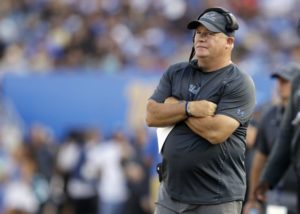
Chip Kelly (“Kelly”) signed a new contract as Head Football Coach for UCLA on November 24, 2017.[179] The Baylor Clause in his contract requires Kelly to be a “Responsible Employee” under Title IX.[180] Specifically, Kelly must report to UCLA’s Title IX officer if he becomes aware of any student who has experienced sexual violence, harassment, or any behavior prohibited by UCLA.[181] Even if untrue or if he is not sure what to believe, Kelly must report to the Title IX office.[182] Additionally, the clause prohibits Kelly and his staff from investigating or intervening in the issue at hand.[183] Kelly is also subject to the University of California Policy on Sexual Harassment and Sexual Violence pursuant to paragraph six of his contract.[184]
Kelly’s contract does include a nine-million-dollar buyout option if UCLA does not find cause for termination during his first 4 years of employment.[185] If Kelly breaches his “Responsible Employee” requirement, the University will have cause for termination, avoiding the buyout fee.[186] Paragraph 10 of Kelly’s contract lays out both Discipline and Termination for Cause.[187] Paragraph 10(a) gives UCLA the right to terminate with cause any, “material breach of any provision of this contract, as determined by the University, [. . .] [including] material failure by Coach to perform, Coach’s duties [. . .].”[188] Additionally, termination for cause under Paragraph 10(e) “[prohibits] a violation by Coach of any legislation, policy, rule, standard or procedure of University, or any applicable law or regulation, or a failure by Coach to report the violation of any of the foregoing by any member of Football assistant coaches and staff or any student athlete.”[189] Thus, Kelly could face termination for cause for a lack of reporting any sexual violence claims to Title IX personnel at UCLA.
- Rutgers University (“Rutgers”)
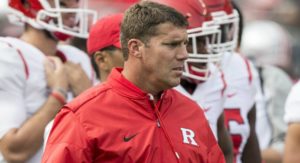
Chris Ash (“Ash”) entered into an agreement with Rutgers to be Rutgers head football coach effective December 7, 2015.[190] Under his contract duties, specifically Section IV(F), Ash “…shall diligently seek to observe and uphold all academic standards, requirements and policies of the University and Athletics in conjunction with the Office of Student-Athlete Academic Support Services [. . . ]. ”[191] Under the compliance section of Ash’s contract, he “shall be subject to all University regulations, policies and procedures and legal requirements generally applicable to other non-aligned employees, including ethical standards and conflict of interest requirements.”[192] Ash is also required “to comply with all federal, state, and local laws, and know and comply with the rules, regulations, ethical standards, and requirements” of the University.[193] Under this contract, Ash shall
immediately report to the Director and Athletics’ Office of NCAA Compliance, in writing, [if Ash] has reasonable cause to believe that any person or entity, including without limitation, representatives of the University’s athletic interests, has violated or is likely to violate or may potentially have violated any of the Rules.[194]
The University may impose discipline upon Ash under Section IX.A.1.,
up to and including termination of employment if after giving him written notice and an opportunity to meet with the Director within two days of such notice, for: [. . .] (vii) a material, intentional, multiple, or repetitive violation of University rules, regulations, policies, or directives. [. . .] [W]hether conduct is “material” will depend on the following: the nature of the conduct; the nature of the rules, regulations or policies in question; or the existence of one or more prior instances of any of the foregoing conduct, without regard to materiality.[195]
- Indiana University (“Indiana”)

Thomas Allen (“Allen”) entered into an employment contract with Indiana on May 31, 2017 to become Indiana’s head football coach.[196] Pursuant to this contract, Indiana may terminate Allen’s employment for cause if:
[a]ny significant, knowing, or repetitive violation by [Allen] of any obligations, duties or responsibilities outlined in [this Agreement,] or any refusal or unwillingness to perform any of such obligations, duties, or responsibilities in good faith and to the best of [Allen]’s abilities; [. . .] [a]ny fraud or dishonestly of [Allen] in the performance of any of his obligations, duties, or responsibilities under this Agreement; [. . .] [and a]ny conduct, including acts or omissions, that misleads the University or the Director of Athletics about any material matters related to the football program, including matters related to [Allen], any assistant coaches or other staff members of any student-athletes.[197]
Under Allen’s contract duties there is no explicit requirement to report Title IX violations. However, Allen’s duties include working “within and support[ing] the rules, regulations, guidelines, and policies of the Athletic Department.”[198]
- University of Alabama (“Alabama”)
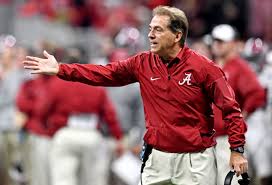
Nick Saban (“Saban”) and Alabama extended Saban’s head football coach contract on or around February 1, 2013.[199] Under Article 5.01(b), the University shall have the right to terminate Saban’s contract for cause for
[f]ailure to promptly report to University’s Title IX Coordinator any violation or allegation of a violation of the University’s Sexual Misconduct Policy that [Saban] is aware of or has reasonable cause to believe is taking place or may have taken place that involve any student, faculty, or staff or that is in connection with a University sponsored activity or event.[200]
- Texas A&M University (“Texas A&M”)
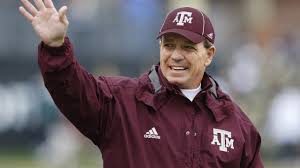
Jimbo Fisher (“Fisher”) and Texas A&M reached an agreement on December 4, 2017 for Fisher to become Texas A&M’s next head football coach.[201] Under Fisher’s duties, specifically Section 2.4 of his contract, Fisher “shall engage in fair, safe and responsible treatment of student-athletes [. . .], and will avoid behavior that jeopardizes a student-athlete’s health, safety, or welfare.”[202] He will also “ensure that the coaches and staff under his supervision also conduct themselves in such a manner.”[203]
Under Section 5.1(e), Termination and Suspension, the University can either suspend Fisher for a period of time without pay or terminate Fisher’s employment for cause if Fisher fails
to promptly report to the University’s Title IX Coordinator or the Athletic Department’s Senior Woman Administrator, or law enforcement in the case of an emergency situation, any information Fisher knows relating to alleged or suspected illegal gender discrimination, sexual harassment, sexual assault, sexual exploitation, intimate partner violence, stalking and/or related retaliation.[204]
- University of Houston (“Houston”)

Major Applewhite (“Applewhite”) and Houston have an almost identical Title IX clause to that in the contract between Ohio State and Urban Meyer.[205] The clause centers around the failure to promptly report and the penalties associated with this failure.[206] Specifically, Applewhite’s contract reads as follows:
Coach shall not . . . fail to promptly report to the University’s Title IX Coordinator any known violations of the UH System Sexual Misconduct Policy that involve any student, faculty, or staff, or that is in connection with a university-sponsored event. . . . For purposes of this Section 4.2.8, a “know violation” shall mean a violation or an allegation for a violation of Title IX that Coach is aware of or has reasonable cause to believe is taking place or may have taken place.[207]
When Applewhite replaced Tom Herman (“Herman”) as head coach of the football team, Houston sought to include a Baylor Clause following the growing trend in college athletics.[208] Herman’s previous contract did not include such a clause regarding reporting requirements. [209]Attorney Robert Lattinville, who represents a number of NCAA clients, expects every head football coach in Power 5 to have a Baylor Clause in their contract in the next few years.[210]
- University of Louisville (“Louisville”) (contract duties)
In March of 2018, Chris Mack (“Mack”) was chosen as the new head basketball coach for the University of Louisville.[211] Paragraph 4, Compliance with Applicable Rules, of Mack’s draft Employment Agreement states as follows:
In performing his duties under this Agreement, Coach shall be familiar with, shall adhere to, and shall promote within the Program an atmosphere of compliance with, all applicable Governing Body Requirements. In addition, Coach shall adhere to all applicable policies, procedures, rules and/or regulations of the Employer and/or the University, as in effect from time to time (including, but not limited to, University policies, procedures, rules, and/or regulations adopted for purposes of compliance with Title IX of the Education Amendments of 1972 (“Title IX”), the Violence Against Women Act’s amendments to the Jeanne Clery Disclosure of Campus Security Policy and Campus Crime Statistics Act, and/or any similar state or local law (“Title IX Policies”)). Coach shall use his best efforts in good faith to cause all Team members, Employer and/or University personnel whom he is responsible for supervising (directly or indirectly), and representatives of the University’s athletics interests to comply with all applicable Governing Body Requirements and Employer and/or University policies, procedures, rules, and/or regulations.[212]
Paragraph 4(c), Reporting, further obligates Mack to duties with respect to Responsible Employees:
In addition, Coach acknowledges that for purposes of Title IX he is a “responsible employee”; consequently, without limiting Coach’s reporting obligations under other Employer and/or University policies, procedures, rules, and/or regulations, if Coach shall become aware of any fact, occurrence, circumstance or state of affairs that he is obligated to report pursuant to the Title IX Policies, he shall immediately and directly report such information to the University’s Title IX Coordinator. If Coach shall become aware of any fact, occurrence, circumstance or state of affairs that would cause a reasonable person to suspect a possible violation of any other Employer or University policy, procedure, rule, and/or regulation, Coach shall immediately report such to the University’s Vice President for Enterprise Risk Management Audit, and Compliance.[213]
Failure for reporting has consequences for Mack as outlined in Paragraph 17(c)(iv), Termination for Cause:
[…] material breach of any Title IX Policy by Coach, it being understood that the foregoing shall not limit the Employer’s right to terminate this Agreement for Cause pursuant to Section 17(c)(i) based upon violations of other Employer or University policies, procedures, rules and/or regulations, or where the underlying conduct otherwise constitutes Cause under this Section 17(c)) […][214]
There is a clear shift in collegiate football regarding coaching contract provisions. This is the “new norm” after major incidents have occurred, including Michigan State/ Larry Nassar, and Penn State/ Jerry Sandusky.[215] It is only a matter of time before a court of law catches up to the ideology behind Baylor Clauses, administrators and coaches must have a moral and contractual obligation in reporting sexual misconduct claims.[216] Aaron Swerdlow, a sports lawyer in California, stated that “every college coach I work with should expect some version . . .” of a Baylor Clause.[217] “The trend among universities is aimed to protect institutions from misconduct by coaches beyond breaking the law or NCAA rules” says Gabe Feldmna, director of Tulane University’s sports law program.[218]
VII. OHIO STATE DILEMMA 
In April of 2018, Ohio State announced that its Board of Trustees had approved a two-year contract extension with Urban Meyer (“Meyer”), resulting in his pay totaling $7.6 million for the next year.[219] The new contract included a raise, with Meyer receiving a $1.2 million dollar increase for this season, and an $800,000 raise the following year.[220] However, the contractual extension was not all about the money – Ohio State implemented a Baylor Clause in Meyer’s contract.[221] Specifically, Paragraph 4.1(e) states as follows:
Coach shall promptly report to Ohio State’s Deputy Title IX Coordination for Athletics any known violations of Ohio State’s Sexual Misconduct Policy (including, but not limited to sexual harassment, sexual assault, sexual exploitation, intimate violence and stalking) that involve any student, faculty, or staff or that is in connection with a university sponsored activity or event. If Ohio State’s Deputy Title IX Coordinator for Athletics is not available, then Coach shall make such report promptly to Ohio State’s Title IX Coordinator. Any emergency situation shall be immediately reported to 911 and/or law enforcement. For Purposes of this Section 4.1 (e), a “known violation” shall mean a violation or an allegation of a violation of Title IX that Coach is aware of or has reasonable cause to believe is taking place or may be taken place.[222]
The lack of reporting a known situation by Meyer shall be means for termination with cause according to Paragraph 5.1(p) which allows Ohio State to remove Meyer from the position without risking the payment of liquidated damages.[223] This clause is becoming the new standard in today’s world of collegiate head coaches, furthering universities efforts to comply with Title IX and stay ahead of sexual violence on campuses. Ironically, Meyer was directly involved in a situation only a few months later, where this clause comes into play, leaving Ohio State’s Board of Trustees in a precarious situation in determining Meyer’s future at the University.
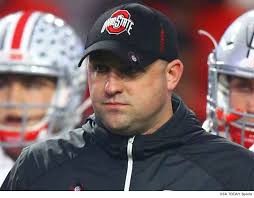 On August 1, 2018, Meyer was placed on administrative leave by Ohio State and an investigation was launched into the circumstances surrounding the termination of Zach Smith (“Smith”).[224] Ohio State focused on what information Meyer was aware of, and how contractually he should have reacted. An extensive report of findings was conducted by Mary Jo White, a litigation partner and Senior Chair of Debevoise & Plimpton LLP, and David Sarrartt, her partner.[225] The investigation conducted over forty witness interviews and reviewed over 60,000 electronic documents.[226] Additionally, over 10,000 text messages were reviewed from Meyer’s phone.[227] Below is a series of facts associated with the situation between Smith, Meyer, Athletic Director Gene Smith, and Ohio State University.
On August 1, 2018, Meyer was placed on administrative leave by Ohio State and an investigation was launched into the circumstances surrounding the termination of Zach Smith (“Smith”).[224] Ohio State focused on what information Meyer was aware of, and how contractually he should have reacted. An extensive report of findings was conducted by Mary Jo White, a litigation partner and Senior Chair of Debevoise & Plimpton LLP, and David Sarrartt, her partner.[225] The investigation conducted over forty witness interviews and reviewed over 60,000 electronic documents.[226] Additionally, over 10,000 text messages were reviewed from Meyer’s phone.[227] Below is a series of facts associated with the situation between Smith, Meyer, Athletic Director Gene Smith, and Ohio State University.


- OHIO STATE’S INDEPENDENT INVESTIGATION FINDINGS
From 2009 through 2018, when Smith was fired from OSU, he was involved in a number of potentially unethical behaviors.[228] The first instance was in 2009, where Smith was arrested for aggravated battery against his pregnant wife, Courtney Smith.[229] Charges were eventually dropped, but Meyer knew of this incident as they were both working at the University of Florida at the time.[230] In 2011, Meyer hired Smith as an assistant coach at OSU after Smith passed a background check.[231] In 2013, Smith was arrested for operating a vehicle while impaired, but neither Meyer nor Gene Smith were aware of this incident.[232]
In May of 2014, Smith ran up a $600 tab at a Miami strip club while on a recruiting trip for OSU.[233] Once Meyer found out about this incident, Meyer utilized the morality clause contained within the 2014 Coaches Manual for OSU coaches to reprimand Smith.[234] In October of 2015, the Title IX Coordinator at the time, Miechelle Willis (“Willis”), was informed of an ongoing investigation of Smith by the Powell Police Department for a domestic violence offense.[235] Willis notified Gene Smith, who relayed this information to Meyer.[236] Gene Smith and Meyer met with Smith and told him that any formal charges would lead to his direct termination from the University.[237] In June of 2016, Smith was admitted to a drug treatment facility on the advice of medical professionals and Meyer.[238]
On May 12, 2018, Smith was charged with criminal trespass after returning to Courtney Smith’s residence.[239] Meyer and Gene Smith were not made aware of this misdemeanor citation until July 20, 2018, when a civil protection order was issued against Smith, who was viewed as an immediate threat of committing domestic violence against Courtney Smith.[240] Finally, on July 23, 2018, Meyer and Gene Smith contacted Smith and informed him of his termination from Ohio State University.[241]
On July 24, 2018, Meyer held his annual press conference at Big 10 Media Day.[242] Meyer was asked questions about what he knew regarding Smith and the two arrests reported on social media.[243] Meyer stated,
“I can’t say that didn’t happen because I wasn’t there. I was never told about anything, never anything came to light. I haven’t had a conversation about it. . . . First I heard about it was last night, . . . people back at the office know nothing about it.”[244]
Both Gene Smith and Head of Football Operations Brian Voltolini (“Voltolini”) were surprised by Meyer’s comments, since they had prepared a plan on how to handle the Smith situation with the media.[245]
Meyer was aware of an open records law investigation into Smith that began in 2015.[246] Additionally, Meyer and Voltolini had a conversation following these reports about how to delete text messages from over a year ago.[247] Subsequently, Meyer was placed on administrative leave by Gene Smith and the investigation began.[248]
On August 22, 2018, the investigation concluded, and the findings were presented to Ohio State’s Board of Trustees.[249] This meeting lasted over ten hours.[250] The Board decided to suspend Meyer for 3 games without pay.[251] He was also suspended from any on-field operations until after week one, where he could coach practices through the week.[252] Additionally, Gene Smith was suspended from August. 31, 2018 through September. 16, 2018.[253]
- ANALYSIS

The conclusion of the factual findings conducted by the independent investigators found potential violations of law, OSU policies and rules, and contractual obligations by Meyer and Gene Smith. [254] With regards to Meyer’s employment contract, section 4.1 states, “[Urban had] a duty to report to both the Athletic Director and Department’s Office of Compliance Services in writing if any person . . . had violated or [was] likely to violate or may potentially violate applicable law.”[255] Meyer maintained his understanding of the reporting procedures only applied when actual charges were filed.[256] Additionally, the investigation found that Meyer had no duty to report Smith’s 2009 domestic violence incident.[257]
Meyer and Gene Smith heavily valued criminal charges and formal arrests when considering the responsibilities of reporting any such misconduct violations by Smith.[258] Meyer was found to genuinely believe if the athletic director reported Smith’s conduct to him, there was nothing further to do.[259] Since Gene Smith was Meyer’s superior, the duty to report was already established in a down sloping manner.[260] This is not the case, as Meyer, pursuant to his contract, “must report to both the Athletic Director and the Department of Compliance. . . .”[261] This type of reporting helps avoid the internalization of issues which hampered Baylor University, among others.
Additionally, Gene Smith had similar reporting duties under his contract.[262] He was responsible for the relay of information to both the Department’s Office of Athletic Compliance and the Office of University Compliance and Integrity.[263] Smith relied on a similar approach as Meyer. Without a formal criminal charge or arrest, the duty to report to other structures in the school did not exist.[264]
The report offered another analysis of why Meyer is responsible for his conduct surrounding both Big 10 Media Day and his conduct in the days after. The investigation cites Meyers contract, Sections 1.5 and 5.1.[265] Section 1.5 required Meyer to hold himself in “high moral, ethical, and academic standards of Ohio State and its Department of Athletics.”[266] Section 5.1 focused on reasons for termination of cause associated with Meyer’s conduct as OSU football head coach.[267] This section states,
“for cause . . . based on bringing . . . Ohio State into public disrepute, embarrassment, contempt, scandal, or ridicule or failure by Coach to conform Coach’s personal conduct to conventional and contemporary standards of good citizenship. . . reflecting unfavorably upon Ohio State’s reputation and overall primary mission and objectives, including but not limited to, acts of dishonest or misrepresentation . . . .”[268]
When both clauses are combined and analyzed in relation to Meyer’s conduct before and after Big 10 Media Day, it is apparent that OSU could have found cause for termination. The Independent Report did not go as far as this reasoning, but concluded that Meyer’s comments on Big 10 Media Day were not logical.[269] Meyer was in direct contact with Gene Smith and other officials after the termination of Smith earlier that day.[270] The conversation that followed, mapped out how Meyer was going to handle media questions surrounding Smith’s firing.[271] Come Media Day, Meyer did not follow the plan and potentially misrepresented to the media his knowledge of both the 2009 and 2015 incidents of domestic violence.[272] He potentially lied directly to the media, and put Ohio State in a “state of media investigation” contrary to Meyer’s contractual obligations.
The investigation does not go into much detail about this direct violation of contractual obligations, but instead gives information regarding the circumstances surrounding why Meyer decided against the agreed upon statements to be made.[273] The investigation stated, “Meyer was deeply absorbed in football season and wanted to focus on football at Big 10 Media Day.”[274] Additionally, they cited Meyer’s memory problems that are a byproduct of medication he takes periodically.[275]
Further, the investigation found Meyer did not want to put Smith’s personal life into the public eye, and that Meyer “didn’t want to be wrong” about any facts associated with Smith.[276] Another piece of evidence of importance was the conversation Meyer had with Voltolini regarding the deletion of text messages.[277] This type of conversation was deemed a “consciousness of guilt” by the investigators, but it is unclear whether Meyer had to actively change settings to delete conversations from over a year ago.[278]
The investigation concluded that Meyer misstated his lack of knowledge of all relevant events regarding Smith’s alleged domestic violence in 2015.[279] The investigation could not conclude that this was intentional, and the reasoning behind the statements made at Media Day were complex.[280] Importantly, the investigation did call into question the process that Ohio State applied through its policies and procedures related to potential incidents of domestic violence and sexual misconduct.[281] The understanding inside OSU’s Athletic Department was without an official arrest or charge filed, the duty to report alleged misconduct was not required.[282] The investigation acknowledged that Meyer and Gene Smith share in the commitment to respect women.[283] The lack of belief that Courtney Smith was telling the truth regarding Smith’s conduct was upsetting, and the disbelief shared by both Meyer and Gene Smith should not be the first thought by a head coach or athletic director.[284]
VIII. CONCLUSION
Regardless of the announcement regarding Meyer’s retirement and subsequent plans to remain at Ohio State in an administrative role, questions need to be asked about both his integrity and the integrity of Ohio State. Throughout this controversy, Meyer maintained his stance free from fault, and waited till after his suspension was announced to tweet an apology to Courtney Smith.[285] Now, after the 2018 college football season has ended, Meyer is rewarded for his service as head coach with an assistant athletic director position at Ohio State.[286] On top of this perk-filled position, Meyer will begin teaching a class on leadership during the spring semester.[287]
Meyer’s decision on retirement was based on a number of factors, citing the impact of a lengthy suspension to start the 2018 seasons, the strength of the Buckeyes football program, and personal health.[288] Now, any retirement based on personal health reasons should be taken at face value. Meyer has cited health concerns over the years and should take a step back to maintain his health.[289] With this being said, to cite the impact of the suspension he received from the University as a factor in deciding retirement is just ludicrous. This statement screams the point that Meyer truly does not understand why exactly he was suspended or how lucky he was to keep his job in the fall. Meyer throughout the fall seemed to think the suspension was unfair to him and his actions regarding Smith were acceptable given his knowledge on the situation.
From the Independent Investigation’s findings, it is safe to conclude that Meyer knew of the first reported incident in 2009 while Meyer and Smith worked for the University of Florida.[290] For nine years, Meyer had to have an inkling of who Smith was as a man. Instead, Meyer got caught in “no man’s land” during Big 10 Media Day and completely misstated his knowledge surrounding Smith and the domestic abuse allegations.[291] The fact that Meyer got to keep his job, retire under his own terms, and was rewarded with another job is at best questionable. His leadership class should last only one session, and be centered around how great leaders are held accountable for their actions. Meyer’s three game suspension was a slap on this wrist, a punishment that simply did not fit the crime.
As egregious as Meyer’s actions were in the grand scheme of things, OSU’s are far worse. As the facts became known and the Independent Investigation was completed, Meyer’s job security never really felt threatened. OSU could have been brave and set a standard for what won’t be tolerated on a college campus. OSU could had made a statement by firing Meyer and protecting the interests of females associated with the University. Unfortunately, OSU decided to punt at this idea, and instead they gave Meyer a golden parachute.
OSU made the safe choice, solely benefitting the football program when it only suspended Meyer. It seems OSU was content with keeping an employee around who protected a possible domestic abuser. This speaks volume to the character of the University. When OSU rewarded Meyer for his service to the University it took an additional step in the wrong direction. The administrators in Columbus need to understand why the entire country is disappointed in their decisions. OSU added a Baylor Clause to Meyer’s contract in April of 2018.[292] Following the incidents at Big Ten Media Day, a “for cause” firing was both appropriate and available for OSU, as Meyer’s contract strictly prohibited the conduct that occurred. Instead, a small suspension, a new job, and a teaching position regarding leadership were Meyer’s rewards for service at the University.
In the wake of the overwhelming scandal that occurred at Baylor, there is an overarching shift in the standard that collegiate head football coaches are held to. As this shift becomes more apparent, more situations like the one at Ohio State will gain media attention. The question centers on the application of a Baylor Clause, and whether this proactive approach is implemented to cover university liability or to fight a culture on collegiate campuses that promotes a welfare of treating student athletes and athletic personnel above the law. Sadly, Ohio State decided to pass up the chance at becoming the first university to put the winning narrative on show. Only time will tell whether universities can make significant strides to alter the cultural dynamics wherein female students and employees must jump many hurdles before claims of sexual violence are taken seriously.
Andrew Mentzer is a second year law student at Marquette University Law School. Andrew is a member of Marquette’s Sports Law Review and is a candidate for the Sports Law Certificate earned through the National Sports Law Institute at Marquette University.
Madeline Wergin graduated from Marquette University Law School with her Juris Doctor and a Sports Law Certificate from the National Institute for Sports Law in December 2018. While attending Marquette, Madeline was a member of the Marquette Sports Law Review. Madeline is continuing her studies at Florida State University to pursue her PhD in Sports Law Analytics.
Thank you to Danelle Welzig, my paralegal, for her assistance in editing and perfecting this article.
[1] Clark C. Griffith, Comments on Title IX, 14 Marq. Sports L. Rev. 57 (2003).
[2] 20 U.S.C. §1681(a).
[3] Diane Heckman, Is Notice Required in a Title IX Athletics Action not Involving Sexual Harassment?, 14 Marq. Sports L. Rev. 175 (2003).
[4] U.S. Dep’t of Educ., Office for Civil Rights, Revised Sexual Harassment Guidance: Harassment of Students by School Employees, Other Students, or Third Parties, 15 (2001). https://www2.ed.gov/about/offices/list/ocr/docs/shguide.pdf
[5] Id. at 13.
[6] Id.
[7] U.S. Dep’t of Educ., Office for Civil Rights, Questions and Answers on Title IX and Sexual Violence, 14, https://www2.ed.gov/about/offices/list/ocr/docs/qa-201404-title-ix.pdf
[8] Sexual and Gender-Based Harassment and Interpersonal Violence Policy, 13, https://www.baylor.edu/titleIX/doc.php/249242.pdf, June 14, 2018.
[9] Id.
[10] Id.
[11] Id.
[12] Id.
[13] Sexual Misconduct, University Policy, 6, https://hr.osu.edu/wp-content/uploads/policy115.pdf, Aug. 23, 2016.
[14] Id.
[15] FAQS Regarding Title IX Best Practices and Compliance, Sexual Misconduct, http://www.marquette.edu/sexual-misconduct/title-ix-faq.php (last visited Sept. 24, 2018).
[16] Id.
[17] Id.
[18] UNL Title IX Responsible Employees, Institutional Equity and Compliance, https://www.unl.edu/equity/unl-title-ix-responsible-employees (last visited Sept. 24, 2018).
[19] Id.
[20] Responsible Employees/Mandated Reporting, Title IX Policies and Procedures, https://www.mtu.edu/title-ix/policy/responsible-employees/ (last visited Sept. 26, 2018).
[21] Am I a Responsible Employee?, Title IX, https://uwm.edu/titleix/information-for-employees/am-i-a-responsible-employee/ (last visited Sept. 26, 2018).
[22] Responsible Employee Resource Guide, http://titleix.utexas.edu/wp-content/uploads/Responsible-Employee-Guide.pdf (last visited Sept. 24, 2018).
[23] Employee FAQs, Stop Sexual Violence, http://stopsexualviolence.iu.edu/employee/employee-faq.html (last visited Sept. 24, 2018).
[24] Policy on Prohibited Discrimination, Harassment, and Related Misconduct, Equal Opportunity and Compliance, https://eoc.unc.edu/our-policies/ppdhrm/ (last visited Sept. 24, 2018).
[25] Timeline: Baylor sexual assault controversy, Waco Tribune-Herald (Jan. 1, 2017), https://www.wacotrib.com/news/higher_education/timeline-baylor-sexaul-assault-controversy/article_abf21ab8-2267-51bf-84d8-6268f4222af0.html.
[26] Id.
[27] Id.
[28] Id.
[29] Id.
[30] Id.
[31] Jake New, Baylor not alone in shielding athletes accused of misconduct from punishment, Inside Higher ED (Feb. 9, 2017), https://www.insidehighered.com/news/2017/02/09/baylor-not-alone-shielding-athletes-accused-misconduct-punishment.
[32] Id.
[33] Jessica Luther & Dan Solomon, Silence at Baylor, Texas Monthly (Aug. 20, 2015), https://www.texasmonthly.com/article/silence-at-baylor/.
[34] Id.
[35] Tommy Witherspoon, Baylor hires Philadelphia firm to investigate sexual assault cases, Waco-Tribune Herald, Sept. 2, 2015, https://www.wacotrib.com/news/higher_education/baylor-hires-philadelphia-firm-to-investigate-sexual-assault-cases/article_e1db4a63-aa27-533a-a4f5-e9ca4f71c5ce.html
[36] Id.
[37] Id.
[38] Baylor University Board of Regents, Findings of Fact, Baylor University, at 4 (May 26, 2016), https://www.baylor.edu/thefacts/doc.php/266596.pdf.
[39] Brief for Respondent at 9, Shillinglaw v. Baylor University Bd. of Reg., et al., No. DC-17-01225, (Tex. D.C., 2017).
[40] Id.
[41] Id.at 10.
[42] Id.
[43] Findings of Fact, supra note 38, at 1.
[44] Id. at 3.
[45] Id. at 4.
[46] Id.
[47] Id.
[48] Id.
[49] Id. at 4.
[50] Id.
[51] Id. at 5.
[52] Id.
[53] Id.
[54] Id. at 6.
[55] Id. at 6.
[56] Id.
[57] Id.
[58] Id.
[59] Id. at 7.
[60] Id.
[61] Id. at 7.
[62] Id. at 8.
[63] Id.
[64] Id. at 10.
[65] Id.
[66] Id.
[67] Id. at 10.
[68] Id.
[69] Id. at 11.
[70] Id.
[71] Id.
[72] Brief for Respondent at 24, Shillinglaw v. Baylor University, DC-17-01225 (Tex. D.C., 2017).
[73] Id. at 25.
[74] Id.
[75] Id.
[76] Id.
[77] Id. at 26.
[78] Brief for Respondent at 26, Shillinglaw v. Baylor University, DC-17-01225 (Tex. D.C., 2017).
[79] Id. at 27.
[80] Id.
[81] Id.
[82] Id. at 28, 29.
[83] Kendall Kaut, DMN Reports Art Briles paid $15.1 Million in Contract Settlement; Ken Starr paid $4.5 Million, SB NATION Our Daily Bears (Mar. 30, 2018), https://www.ourdailybears.com/2018/3/30/17182962/dmn-reports-art-briles-paid-15-1-million-in-contract-settlement-ken-starr-paid-4-5-million.
[84] Id.
[85] Wade Goodwyn, Baylor Sanctioned By Big 12 After New Revelations About Sexual Assault Controversy, NPR (Feb. 8, 2017), https://www.npr.org/2017/02/08/514172776/baylor-sanctioned-by-big-12-after-new-revelations-about-football-team-controvers.
[86] Id.
[87] Id.
[88] Id.
[89] Id.
[90] Courtney Cameron, Baylor produces text evidence, Briles drops libel suit, Athletic Business (Feb. 2017), https://www.athleticbusiness.com/civil-actions/baylor-produces-text-evidence-briles-drops-libel-suit.html.
[91] Id.
[92] Tommy Witherspoon, Judge throws out lawsuit from former BU athletic staffer, Waco Tribune Herald (July7, 2017), https://www.wacotrib.com/news/courts_and_trials/judge-throws-out-lawsuit-from-former-bu-athletics-staffer/article_f59ff0bd-8fc3-54e7-a517-da706093d75f.html.
[93] Id.
[94] Id.
[95] Mac Engel, Exclusive: Baylor received notice of allegations from NCAA, Star-Telegram (Oct. 1, 2018), https://www.star-telegram.com/sports/spt-columns-blogs/mac-engel/article219285540.html.
[96] Id.
[97] Dennis Dodd & Adam Silverstein, Baylor receives notice of allegations from NCAA for lack of institutional control, CBSSPORTS (Oct. 2, 2018), https://www.cbssports.com/college-football/news/baylor-receives-notice-of-allegations-from-ncaa-for-lack-of-institutional-control/.
[98] Id.
[99] Order, Jane Doe 1, et al. v. Baylor University, No. 6:16-CV-173-RP (W.D. Tex., Mar. 7, 2019).
[100] Id.
[101] Id.
[102] Id.
[103] Motion of Pepper Hamilton LLP Objecting to the Production of Documents and for Specific Relief pursuant to the Court’s order dated march 7, 2019, Jane Doe 1, et al. v. Baylor University, No. 6:16-CV-173-RP (W.D. Tex., Mar. 7, 2019).
[104] Id.
[105] Id.
[106] Id.
[107] Id.
[108] Naomi Martin, Sexual Assault Survivors Say Texas A&M Chose Its Brand Over Justice, The Dallas Morning News, June 29, 2018, https://www.dallasnews.com/news/texas/2018/06/29/sexual-assault-survivors-say-texas-am-chose-brand-justice
[109] Id.
[110] Id.
[111] Id.
[112] Id.
[113] Id.
[114] Compl. at 2, Van Overdam v. Texas A&M University, https://www.courtlistener.com/recap/gov.uscourts.txsd.1524836/gov.uscourts.txsd.1524836.1.0.pdf
[115] Id.
[116] Id.
[117] Martin, supra note 108.
[118] Id.
[119] Id.
[120] Travis L. Brown, Sexual Assault Survivor, Advocate Speak Out on Texas A&M Allegation, The Eagle, June 12, 2018, https://www.theeagle.com/news/a_m/sexual-assault-survivor-advocate-speak-out-on-texas-a-m/article_357f2610-6ea3-11e8-b6f5-374c0b21dc6e.html
[121] Martin, supra note 108.
[122] Id.
[123] Id.
[124] Id.
[125] Id.
[126] Benjamin Fearnow, Texas A&M Swimmer Accused of Rape Sues School for ‘Bias Against Male Students,’ Newsweek, June 19, 2018, https://www.newsweek.com/texas-am-rape-title-ix-bias-austin-van-overdam-hannah-shaw-swimmer-sexual-984462
[127] Id.
[128] Id.
[129] Martin, supra note 108.
[130] Id.
[131] Id.
[132] Id.
[133] Id.
[134] Id.
[135] Id.
[136] Id.
[137] Id.
[138] Id.
[139] Id.
[140] Id.
[141] Id.
[142] Id.
[143] Id.
[144] Id.
[145] Id.
[146] Id.
[147] Id.
[148] Id.
[149] Id.
[150] Lindsay Ellis, Texas A&M to review sexual misconduct sanctions after student backlash, Houston Chronicle, June 30, 2018, https://www.houstonchronicle.com/news/houston-texas/texas/article/Texas-A-M-to-review-sexual-misconduct-sanctions-13038918.php.
[151] Shannon Najmabadi, Following Backlash, Texas A&M Overhauls Its Sexual Misconduct Policies, The Texas Tribune, Aug. 20, 2018, https://www.texastribune.org/2018/08/20/texas-m-overhauls-its-title-ix-sexual-misconduct-policies/
[152] Michael K. Young, Comprehensive Reviews, Actions And Next Steps on Sexual Assault Policies, Texas A&M Today, July 2, 2018 https://today.tamu.edu/2018/07/02/comprehensive-reviews-actions-and-next-steps-on-sexual-assault-policies/
[153] Announcing Title IX Review Reports and Actions, Office of the President, Aug. 20, 2018, https://president.tamu.edu/messages/announcing-title-IX-review-reports actions.html?_ga=2.54980578.812804315.1538774941-2123712755.1535655152
[154] Id.
[155] Id.
[156] Id.
[157] Id.
[158] Id.
[159] Id.
[160] Id.
[161] Id.
[162] Id.
[163] Id.
[164] Id.
[165] Daniel Jonathan Durkin, University of Maryland Head Football Coach Employment Agreement, ¶ 5 (Dec. 3, 2015).
[166] Id.
[167] Id.
[168] Id.
[169] Id.
[170] Durkin employment agreement, supra note 165, at ¶ 12(c).
[171] Id.
[172] Id.
[173] Id.
[174] Lovie L. Smith, Board of Trustees of the University of Illinois Employment Agreement (Sept. 8, 2016).
[175] Id. at § 3.2(j).
[176] Id. at § 5.2.
[177] Id.
[178] Id.
[179] Joe Piechowski, UCLA Football: Chip Kelly’s Contract has some Interesting Provisions, Bruins Nation (Jan. 6, 2018), https://www.bruinsnation.com/ucla_bruin_football/2018/1/6/16857272/ucla-football-chip-kellys-contract-has-some-interesting-provisions.
[180] Id.
[181] Charles Edward Kelly, The Regents of the University of California, Los Angeles campus Employment Contract, ¶ 8 (Nov. 25, 2017).
[182] Id.
[183] Id.
[184] Id. at ¶ 6.
[185] Piechowski, supra note 179.
[186] Id.
[187] Kelly employment agreement, supra note 181, at ¶ 10.
[188] Id.
[189] Id.
[190] Chris Ash, Division of Intercollegiate Athletics Full-Time Head Football Coach Employment Contract (Nov. 25, 2017).
[191] Id.
[192] Id.
[193] Id.
[194] Id.
[195] Id.
[196] Thomas Allen, Indiana University Employment Agreement (May 31, 2017).
[197] Id.
[198] Id.
[199] Nick L. Saban, Second Amended and Restated Head Coach Employment Contract (Feb. 1, 2013).
[200] Id.
[201] Alex Kirshner, Jimbo Fisher’s $75 million A&M contract is even more hilariously one-sided than you thought, SBNATION (Aug. 22, 2018), https://www.sbnation.com/college-football/2018/8/22/17769874/jimbo-fisher-texas-a-m-contract.
[202] John J. Fisher, Jr., Texas A&M University Agreement Final (Aug. 16, 2018).
[203] Id.
[204] Id.
[205] Sam Bruchar, University of Houston’s Major Applewhite among coaches with specific Title IX reporting provisisons, Sports Lobby (Aug. 7, 2018), http://thesportlobby.com/university-houston-major-applewhite-title-ix-reporting-provisions/.
[206] Id.
[207] Major Applewhite, University of Houston Employment Agreement (Dec. 12 , 2016).
[208] Bruchar, supra note 205.
[209] Id.
[210] Id.
[211] Kenny Klein, Chris Mack Chosen to lead Louisville Men’s Basketball Program, GoCards.com, Mar. 28, 2018, https://gocards.com/news/2018/3/28/chris-mack-chosen-to-lead-louisville-mens-basketball-program.aspx.
[212] Christopher L. Mack, University of Louisville Draft Employment Agreement (Mar. 28, 2018).
[213] Id.
[214] Id.
[215] William Gibbs, Coaching more than X’s, O’s in #MeToo times, Chicago Daily Law Bulletin, Sept. 25, 2018.
[216] Id.
[217] Kantele Franko, That scrutinized bit of Meyer’s OSU contract may be new norm, AP News (Aug. 20, 2018), the scutinized bit of meyers contract ap news.
[218] Id.
[219] Steve Berkowitz, New Contract provisions could pose problem as Ohio State’s Urban Meyer is places on leave, USA Today (Aug. 1, 2018), https://www.usatoday.com/story/sports/ncaaf/bigten/2018/08/01/ohio-state-coach-urban-meyers-amended-contract-could-pose-problem/885020002/.
[220] Id.
[221] Id.
[222] Urban Meyer, The Ohio State University Employment Agreement, Addendum 4, ¶ 4.1(e) (Feb. 1, 2018).
[223] Id.
[224] Mark Tracy, Urban Meyer Placed on Paid Leave at Ohio State Following New Allegations, NY Times (Aug., 1, 2018).
[225] The Ohio State University, The Independent Investigation Summary of Findings, at 2 (Aug. 22, 2018), https://news.osu.edu/download/579626/osusummaryoffindings-finaldesktop.pdf.
[226] Id.
[227] Id. at 2.
[228] Id. at 3.
[229] Id.
[230] Id. at 4.
[231] Id.
[232] Id. at 6.
[233] Id.
[234] Id.
[235] Id.
[236] Id.
[237] Id.
[238] Id. at 9.
[239] Id. at 10.
[240] Id.
[241] Id. at 12.
[242] Id.
[243] Id.
[244] Id. at 13.
[245] Id.
[246] A.J. Perez, Ohio State’s report on Urban Meyer investigation raises questions about text message history, USA Today (Aug. 23, 2018), htpps://www.usatoday.com/story/ncaa/2018/08/23/ohio-state-report-urban-meyer-text-history-concerning/10706560027.
[247] Id.
[248] Id.
[249] Dan Murphy, Ohio State’s board discussion on Urban Meyer probe surpasses 11 hours, ESPN (Aug. 22, 2018), http://www.espn.com/college-football/story/_/id/24444109/ohio-state-buckeyes-trustees-begin-discussing-urban-meyer-probe.
[250] Id.
[251] Kevin Allen & Paul Myerberg, Ohio State suspends football coach Urban Meyer three games: “I want to apologize”, USA Today (Aug. 22, 2018), https://www.usatoday.com/story/sports/ncaa/bigten/2018/08/22/ohio-state-suspends-urban-meyer-investigation/10184770027.
[252] Id.
[253] Id.
[254] Independent Investigation, supra note 225, at 17.
[255] Meyer Employment Agreement, supra note 222.
[256] Id.
[257] Independent Investigation, supra note 225, at 17.
[258] Id. at 18.
[259] Id.
[260] Id.
[261] Meyer Employment Agreement, supra note 222.
[262] Independent Investigation, supra note 225, at 17.
[263] Id.
[264] Id.
[265] Id. at 18.
[266] Id.
[267] Id.
[268] Meyer Employment Agreement, supra note 222.
[269] Independent Investigation, supra note 225, at 19
[270] Id.
[271] Id.
[272] Id.
[273] Id.
[274] Id.
[275] Id. at 20.
[276] Id.
[277] Id. at 21.
[278] Id.
[279] Id.
[280] Id.
[281] Id. at 22.
[282] Id.
[283] Id.
[284] Id.
[285] Adam Woodare, Ohio State’s Urban Meyer tweets apology to Courtney Smith, apologizes for ‘words and demeanor’, USA Today, Aug. 24, 2018, https://www.usatoday.com/story/sports/ncaaf/bigten/2018/08/24/ohio-state-urban-meyer-apologizes-courtney-smith-twitter/1089256002/.
[286] Adam Rittenberg, Urban Meyer to teach leadership course at OSU after retiring, ESPN (Dec. 20, 2018), http://www.espn.com/college-football/story/_/id/25583852/urban-meyer-teach-leadership-class-ohio-state-buckeyes-business-school.
[287] Id.
[288] Dan Murphy & Adam Rittenberg, Urban Meyer to retire after Rose Bowl, with Ryan Day taking over as Buckeyes head coach, ESPN (Dec. 4, 2018), http://www.espn.com/college-football/story/_/id/25449933/ohio-state-buckeyes-head-coach-urban-meyer-retire-coaching-rose-bowl.
[289] Id.
[290] Tracy, supra note 224.
[291] Allen, supra not 251.
[292] Berkowitz, supra note 219.


